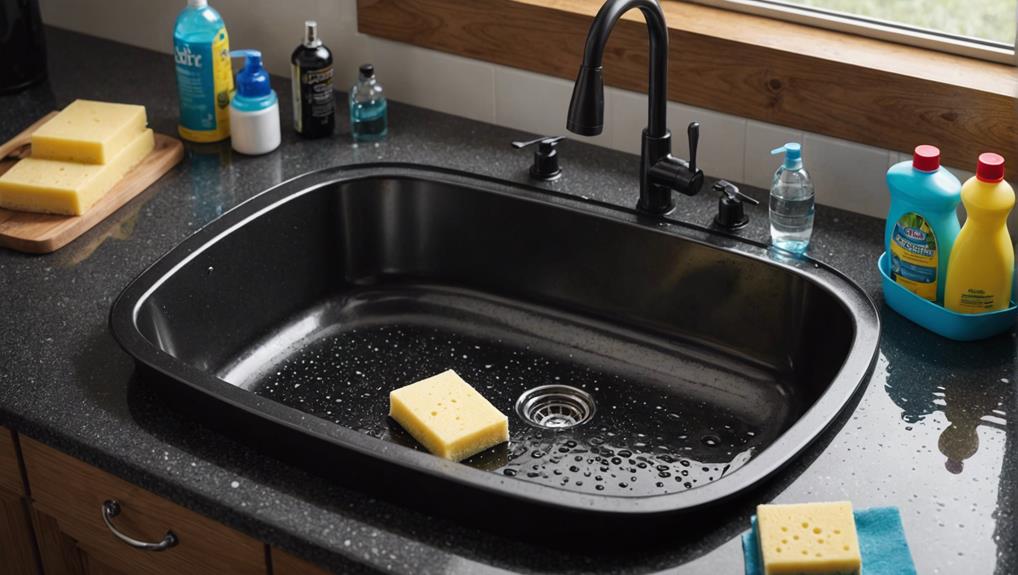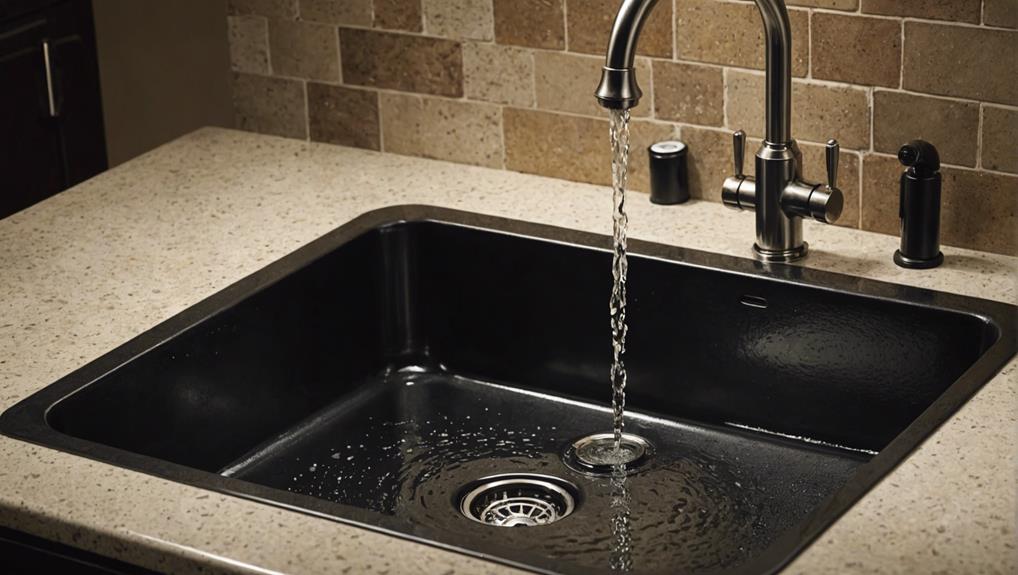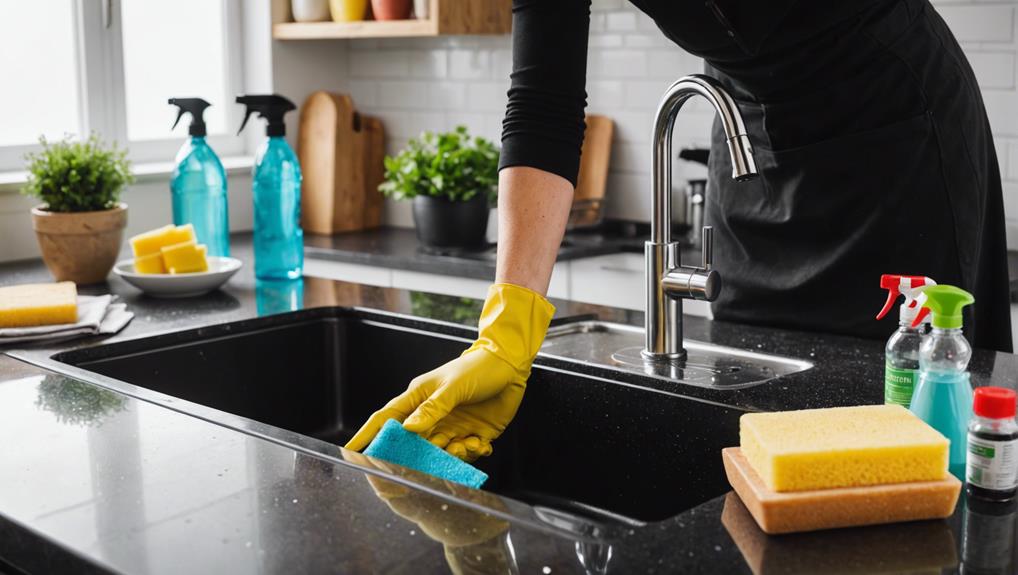
10 Easy Steps to Clean Your Black Kitchen Sink
Keep your black kitchen sink spotless with these ten steps. Gather supplies: distilled white vinegar, dish soap, baking soda, spray bottle, and rubber gloves. Remove debris using soft tools. Rinse with warm water. Apply dish soap and scrub gently with a non-abrasive sponge. Spray the vinegar solution and scrub again. Rinse thoroughly. Dry completely with a microfiber cloth to avoid water spots. Apply a thin layer of vegetable oil using a soft cloth, let it sit, then wipe off excess. For maintaining that pristine look, there’s more you can discover to keep your sink looking its best.
Key Takeaways
- Use distilled white vinegar and water solution to spray and scrub the sink.
- Remove surface debris with soft tools, focusing on corners and crevices.
- Create a baking soda paste for stubborn stains and scrub gently.
- Dry the sink thoroughly with a microfiber cloth to prevent water spots.
- Apply a thin layer of vegetable oil for enhanced shine and protection.
Gather Your Supplies
To clean your black kitchen sink effectively, gather supplies like soft cloths, distilled white vinegar, dish detergent, baking soda, and a spray bottle. Begin by ensuring you have all necessary items at hand. Rubber gloves will protect your hands, while a nylon scrub brush and microfiber cloth will help you clean efficiently. Additionally, have a lint-free cloth and clean hot water ready for drying the sink afterward.
Choosing essential products is important for a sustainable cleaning routine. Distilled white vinegar and baking soda are both excellent choices that are kind to the environment and highly effective. Dish detergent should be biodegradable and free of harsh chemicals. These choices not only protect the planet but also keep your home safe from toxic residues.
Organizing your cleaning schedule will streamline your routine. Set a regular time each week to clean your sink, ensuring it remains spotless and hygienic. This can prevent buildup and make each cleaning session quicker.
Remove Debris
Start by clearing the surface of your sink, removing any food scraps or solid waste with a strainer or your hands.
Dispose of these scraps properly to prevent clogs and keep your sink hygienic.
Clear the Surface
Begin by using a soft brush or cloth to meticulously remove any debris and food particles from the surface of your black kitchen sink. This initial step is important, especially for maintaining the sink material. Gently sweep away crumbs and bits of food to guarantee a clean start. Don’t rush; take your time to make sure all visible debris is gone.
Next, focus on the corners and crevices of your black sink. These areas often trap grime and can be easily overlooked. Use the edge of your cloth or a soft brush to reach into these tight spots, making sure no debris is left behind.
Once you’ve cleared the surface, wipe down the sink with a gentle cleanser or soapy water. This step is one of the essential cleaning techniques to eliminate any remaining dirt or grime. Opt for a mild cleaner that’s safe for your sink material to avoid any potential damage.
Regularly clearing the surface of your sink is one of the best maintenance tips to prevent stains and buildup. By keeping your black sink free of debris, you ensure it stays looking pristine.
With a clean surface, you can effectively move on to deeper cleaning methods, guaranteeing a sparkling finish.
Dispose of Scraps
Proper disposal of food scraps and debris is essential for maintaining a clean, odor-free black kitchen sink. Start by using a sink strainer to catch food scraps and debris before they go down the drain. This simple tool is indispensable for effective kitchen hygiene. Place the strainer in your sink drain and make sure it fits securely.
Next, make sure that you dispose of large food particles in the trash. Avoid rinsing them down the drain, as they can contribute to clogs and build-up. When you encounter grease and oils, it’s important to keep them out of the sink. These substances can solidify and cause blockages, leading to unpleasant odors and potential damage over time.
Regular maintenance of the sink strainer is also essential. Make it a habit to check and clean the strainer daily. This prevents food particles from accumulating and ensures proper drainage. Implementing this routine will greatly improve your food waste management practices.
Check Drainage System
To guarantee your black kitchen sink remains free of clogs and odors, regularly inspect and clear the drainage system of any debris. Start your drainage inspection by removing the sink strainer or stopper. Carefully use a drain cleaner tool to fish out any visible debris, such as food particles or hair. This step is important for odor prevention and maintaining efficient water flow.
Next, prepare a mixture of equal parts vinegar and baking soda. Pour half a cup of baking soda into the drain, followed by half a cup of vinegar. The combination will fizz, helping to break down any remaining buildup. Allow it to sit for about 15 minutes. Afterward, flush the drain with hot water for a few minutes to make sure all loosened debris is washed away.
For thorough odor prevention, make drainage inspection a routine task. Regularly cleaning your drain not only keeps it free of blockages but also prevents the slow drainage that leads to unpleasant smells. By maintaining a clean drainage system, you’ll make sure your sink operates efficiently and remains a pleasant part of your kitchen. Don’t neglect this important step in your sink maintenance routine.
Rinse With Warm Water

Rinse your black kitchen sink with warm water to effortlessly remove surface debris and food particles. The right water temperature is important for this task. Warm water, specifically, helps to loosen dirt and grime, making it easier to clean without the risk of scratching the sink surface. This step is essential for proper surface maintenance and prepares your sink for the next cleaning phases.
Using warm water guarantees that you’re not just moving debris around but effectively washing it away. Here’s how to proceed:
- Adjust the water temperature to warm, making sure it’s comfortable to the touch but not too hot.
- Direct the warm water flow across the entire sink, targeting areas where food particles and grime accumulate.
- Use a gentle stream to avoid splashing yet cover all corners and edges.
- Rinse thoroughly for at least 30 seconds, making sure that all visible debris is washed away.
- Inspect the sink surface to confirm that no particles remain, as lingering debris can scratch during subsequent cleaning steps.
Regularly rinsing your black kitchen sink with warm water not only maintains its cleanliness but also preserves its sleek appearance and functionality.
Apply Dish Soap
Having rinsed away the surface debris with warm water, now apply a small amount of dish soap directly to the surface of your black kitchen sink. This step is essential for effective surface cleaning. Use a soft sponge or cloth to distribute the dish soap evenly, making sure you cover all areas of the sink. The soap application should focus on areas with visible food residue or stains.
Next, create a soapy lather by gently working the dish soap into the surface. This will help in lifting any remaining grime and making your sink look spotless. Here’s a quick guide to help you with this step:
| Task | Tools Needed | Description |
|---|---|---|
| Apply Dish Soap | Dish soap | Pour a small amount onto the sink |
| Distribute Soap | Soft sponge or cloth | Spread soap evenly across the surface |
| Focus on Stains | Soft sponge or cloth | Pay extra attention to stained areas |
| Create Lather | Soft sponge or cloth | Work soap into a lather for cleaning |
Make sure to be thorough in your soap application to make sure no spot is missed. This methodical approach ensures that your black kitchen sink stays in pristine condition.
Scrub Gently
To scrub your black kitchen sink gently, use a soft abrasive sponge or a nylon scrub brush.
Avoid harsh scrubbers or abrasive cleaners that can damage the sink’s surface.
Scrub in gentle, circular motions to effectively remove stains and food particles without causing any scratches.
Choose Soft Scrubbing Tools
When cleaning your black kitchen sink, it’s important to use a soft abrasive sponge or nylon scrub brush to prevent scratches and maintain its pristine appearance. Soft cleaning tools are essential for scratch prevention, guaranteeing your sink remains in top condition.
Opt for a soft abrasive sponge or a nylon scrub brush, both of which are gentle on the surface yet effective in removing grime and stains.
Using gentle scrubbing techniques is vital for proper sink maintenance. Scrub in circular motions to lift dirt without applying excessive pressure. This method ensures that you clean thoroughly while preserving the sleek look of your black sink.
To give you a clearer picture, here’s what you should focus on:
- Soft cleaning tools: Choose a soft abrasive sponge or nylon scrub brush.
- Scratch prevention: Avoid any abrasive scrubbers that could damage the surface.
- Gentle scrubbing: Use circular motions to remove dirt effectively.
- Sink maintenance: Regular gentle cleaning helps maintain the sink’s condition.
- Effective cleaning: Soft tools guarantee thorough cleaning without damage.
Avoid Abrasive Cleaners
Guarantee not to use abrasive cleaners on your black kitchen sink because they can easily scratch the surface and ruin its sleek appearance. Proper maintenance is crucial to keep your sink looking pristine.
Abrasive cleaners, including harsh chemicals and rough scrubbers, can strip away the sink’s finish over time. This not only diminishes the aesthetic appeal but also impacts the sink’s durability.
To secure long term effects of a well-maintained sink, always opt for gentler cleaning methods. Use a soft sponge or cloth when scrubbing. This minimizes the risk of scratches and preserves the sink’s slick surface.
Natural cleaning solutions like baking soda and vinegar are excellent alternatives. They effectively clean without the harshness of abrasive cleaners.
Gentle Circular Motions
Scrubbing your black kitchen sink with gentle, circular motions guarantees you effectively remove dirt and grime without scratching the surface. Circular scrubbing is a key technique for maintaining the pristine look of your sink. By applying gentle pressure, you certify that the cleaning solution is evenly distributed, which helps in breaking down residues without damaging the finish.
To get the best results, follow these steps:
- Use a soft sponge or cloth: Opt for non-abrasive materials to avoid scratching.
- Apply a mild cleaning solution: Harsh chemicals can damage your sink’s surface.
- Scrub in circular motions: This assures an even clean and protects the sink’s finish.
- Rinse thoroughly: Remove all cleaning residues to prevent streaks and spots.
- Wipe dry with a soft towel: This helps prevent water spots and keeps your sink looking shiny.
Tackle Stubborn Stains
For those persistent stains on your black kitchen sink, start by creating a paste with baking soda and water to scrub the area gently. This method not only helps with stain prevention but also guarantees a deep cleaning without damaging the sink’s surface. Use a soft-bristled nylon brush to apply the paste. This type of brush is gentle enough to avoid scratches yet effective in removing stubborn grime.
Let the baking soda paste sit on the stain for a few minutes. This waiting period allows the paste to break down the grime, making it easier to scrub away. Once the time is up, scrub the area gently but firmly in circular motions.
After scrubbing, rinse the sink thoroughly with lukewarm water to remove any leftover residue. This step is essential for maintaining the sink’s shine and preventing any baking soda from drying and forming new stains. Dry the sink completely with a microfiber cloth to avoid water spots and keep it looking pristine.
Using eco-friendly alternatives like baking soda not only preserves your sink’s material but also reduces the need for professional help. This method is both effective and environmentally responsible.
Use Vinegar Solution

To clean your black kitchen sink, mix equal parts water and distilled white vinegar in a spray bottle.
Spray the solution generously onto the sink’s surface, ensuring it covers all areas.
Use a soft sponge or nylon brush to gently scrub away dirt and grime before rinsing thoroughly and drying with a microfiber cloth.
Mixture Ratios Explained
A 1:1 mixture of distilled white vinegar and water is your go-to solution for effectively cleaning and maintaining your black kitchen sink. This simple yet powerful combination helps break down soap scum, mineral deposits, and other residues that can dull your sink’s appearance. Vinegar’s acidic properties make it an effective natural cleaner, ideal for removing stains and limescale buildup. Here are some key points to keep in mind:
- Vinegar benefits: Natural, non-toxic, and effective against a range of stains and buildups.
- Disadvantages: Strong smell and potential to damage certain surfaces if not rinsed thoroughly.
- Alternative cleaning methods: Baking soda paste, commercial cleaners, or mild dish soap can also be used.
- Ease of use: Simply mix equal parts vinegar and water in a spray bottle for easy application.
- Maintenance: Regular use of this solution helps keep your black sink looking clean and shiny.
While vinegar is a versatile and eco-friendly solution, it’s important to be aware of its limitations. For instance, the strong smell can be off-putting, and improper rinsing may leave residues that could damage certain surfaces over time.
Application Tips
Start by filling a spray bottle with a 1:1 mixture of distilled white vinegar and water for an effective and eco-friendly cleaning solution. This vinegar application is perfect for breaking down soap scum, mineral deposits, and limescale that can accumulate in your black kitchen sink.
To begin, spray the vinegar solution generously over the entire sink surface, ensuring thorough coverage. The acidic properties of vinegar make it a natural cleaner that’s both safe for daily use and effective at maintaining your sink’s finish and shine. Allow the solution to sit for about 5-10 minutes. This essential time is important as it lets the vinegar work its magic, loosening any stubborn residues.
Next, use a soft sponge or cloth to gently scrub the sink. Focus on any areas with visible buildup, employing small, circular motions. This cleaning technique ensures that you’re not only removing surface grime but also maintaining the integrity of the sink’s finish.
Rinse thoroughly with warm water to wash away the loosened debris and any remaining vinegar solution.
Rinse Thoroughly
Rinse your black kitchen sink thoroughly after each use to prevent residue and build-up from tarnishing its sleek appearance. Consistently rinsing your sink is a key step to prevent buildup and maintain its pristine look.
Use clean, lukewarm water to make certain all soap, dirt, and food particles are washed away. This simple yet effective habit will help you maintain the appearance of your sink, keeping it free from stains and water spots.
Here’s a detailed approach to rinsing your sink:
- Use lukewarm water: Lukewarm water is ideal for removing residues without causing any thermal stress to the sink material.
- Rinse all surfaces: Ensure you thoroughly rinse every part of the sink, including the sides and the bottom.
- Focus on corners: Pay special attention to corners and edges where grime tends to accumulate.
- Rinse immediately after use: Make it a habit to rinse the sink after each use to prevent residue from drying and hardening.
- Check for limescale: Regular rinsing helps in preventing limescale and hard water stains, particularly if you live in an area with hard water.
Dry Completely

After rinsing, make sure to dry your black kitchen sink completely to prevent water spots and mineral buildup. Start by grabbing a microfiber cloth, which is ideal for this task because it’s highly absorbent and gentle on surfaces. Using a microfiber cloth guarantees that you won’t leave any streaks or residue behind.
Begin at one end of the sink and methodically move to the other, making sure you cover all areas, including the corners and edges. This thorough approach to drying is vital for preventing streaks and maintaining the sink’s shine. Pay special attention to the faucet area, as water tends to accumulate here.
Regularly drying your sink after each use is one of the simplest yet most effective drying techniques. This habit not only keeps your sink looking pristine but also helps in preventing dullness over time. Avoid leaving standing water, as it can lead to water stains and mineral deposits that are more challenging to remove.
Properly drying your black kitchen sink is essential for keeping it looking clean and well-maintained. By incorporating these drying techniques into your routine, you’ll make sure your sink remains a focal point of your kitchen, free from unsightly spots and dullness.
Apply Vegetable Oil
Applying vegetable oil to your black kitchen sink not only enhances its appearance but also serves as a protective barrier against water spots and stains.
Start by making sure your sink is thoroughly dry. Use a clean, soft cloth to apply a thin layer of vegetable oil. Gently rub the oil in circular motions to ensure even coverage. This method will add a subtle shine and create a surface that repels water and stains effectively.
Let the vegetable oil sit for a few minutes before wiping off any excess with a dry cloth. This step is important as it ensures that the oil has enough time to form a protective layer without leaving a greasy residue.
Benefits of this method include:
- Enhanced shine: Gives your sink a sleek, polished look.
- Water resistance: Prevents water spots and stains from forming.
- Easy application: Takes just a few minutes.
- Non-toxic: Safe for food preparation areas.
- Cost-effective: An inexpensive maintenance solution.
For alternatives, you might consider mineral oil or specialized sink protectants, though vegetable oil is often more accessible.
To maintain the pristine look of your sink, apply vegetable oil every one to two weeks. Regular maintenance will keep your sink looking new and stylish.
Frequently Asked Questions
How Do You Clean a Black Kitchen Sink?
You should clean your black kitchen sink daily with hot soapy water. Use natural cleaners like baking soda for tough stains. Regularly rinse and dry to prevent build-up. Apply mineral oil monthly to maintain its luxurious appearance.
Are Black Kitchen Sinks Easy to Keep Clean?
Yes, black kitchen sinks are easy to keep clean due to their material durability and stain resistance. Regular cleaning with hot, soapy water and a soft cloth maintains their appearance, preserving their sleek and luxurious look effortlessly.
How Do You Keep a Black Sink From Turning White?
To keep a black sink from turning white, use preventive measures like a vinegar and water solution. Regularly clean with mild cleaning products and dry thoroughly after each use. Avoid harsh chemicals to maintain the sink’s appearance.
How Do You Keep Water Stains Out of a Black Sink?
To maintain water stains out of a black sink, rinse and dry it after use. Use a vinegar solution to scrub stains gently. Install a water softener to reduce mineral deposits. Regular maintenance guarantees long-lasting cleanliness.
Conclusion
Now that you’ve followed these steps, your black kitchen sink should sparkle like new.
You’ve gathered your supplies, removed debris, and thoroughly rinsed with warm water.
You applied dish soap, scrubbed gently, and used a vinegar solution for a deep clean.
After rinsing thoroughly and drying completely, you finished by applying vegetable oil for a lasting shine.
Stick to this method, and your sink will stay pristine and elegant, making your kitchen a standout feature.



Leave a Reply